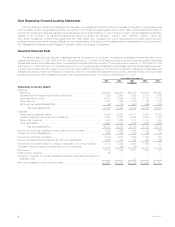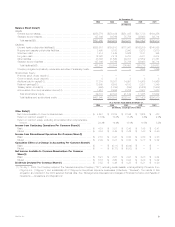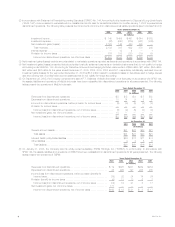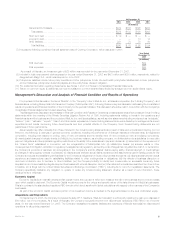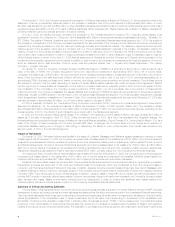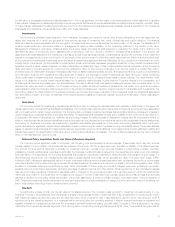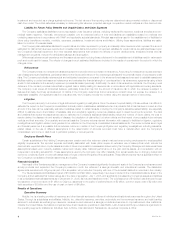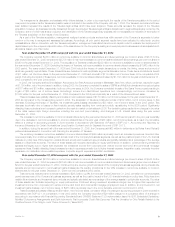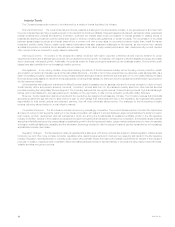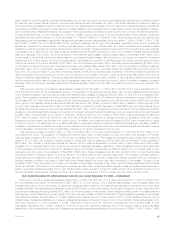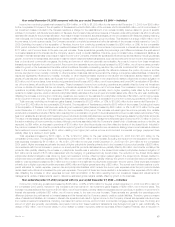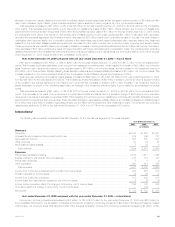MetLife 2005 Annual Report Download - page 15
Download and view the complete annual report
Please find page 15 of the 2005 MetLife annual report below. You can navigate through the pages in the report by either clicking on the pages listed below, or by using the keyword search tool below to find specific information within the annual report.Premiums, fees and other revenues increased by $3,694 million, or 14%, to $29,959 million for the year ended December 31, 2005 from
$26,265 million for the comparable 2004 period. The current period includes $1,009 million of premium, fees and other revenues related to the
acquisition of Travelers. Excluding the acquisition of Travelers, premium, fees and other revenues increased by $2,685 million, or 10%. The Institutional
segment contributed $1,266 million, or 47%, to the year over year increase. The Institutional segment increase is primarily due to sales growth and the
acquisition of new business in the non-medical health & other business, as well as improved sales and favorable persistency in group life and higher
structured settlement sales and pension close-outs in retirement & savings. The Reinsurance segment contributed $523 million, or 19%, to the
Company’s year over year increase in premiums, fees and other revenues. This growth is primarily attributable to new premiums from facultative and
automatic treaties and renewal premiums on existing blocks of business, as well as favorable exchange rate movements. The International segment
contributed $452 million, or 17%, to the year over year increase primarily due to business growth through increased sales and renewal business in
Mexico, South Korea, Brazil, and Taiwan, as well as changes in foreign currency rates. In addition, Chile’s premiums, fees and other revenues increased
due to the new bank distribution channel established in 2005. The Individual segment contributed $445 million, or 17%, to the year over year increase
primarily due to higher fee income from variable annuity and universal life products, active marketing of income annuity products and growth in the
business in traditional life products. The growth in traditional products more than offset the decline in premiums in the Company’s closed block business
as this business continues to run-off. Corporate & Other contributed $38 million, or 1%, to the year over year increase, primarily due to intersegment
eliminations. The increase in premiums, fees and other revenues were partially offset by a decrease in the Auto & Home segment of $39 million, or 1%.
This decrease is primarily attributable to reinstatement and additional reinsurance-related premiums due to Hurricane Katrina.
Interest rate margins, which generally represent the margin between net investment income and interest credited to policyholder account balances,
increased in the Institutional and Individual segments for the year ended December 31, 2005 compared to the prior year period. Earnings from interest
rate spreads are influenced by several factors, including business growth, movement in interest rates, and certain investment and investment-related
transactions, such as corporate joint venture income and bond and commercial mortgage prepayment fees, the timing and amount of which are generally
unpredictable and, as a result, can fluctuate from period to period. If interest rates remain low, it could result in compression of the Company’s interest
rate spreads on several of its products, which provide guaranteed minimum rates of return to policyholders. This compression could adversely impact the
Company’s future financial results.
Underwriting results were favorable within the life products in the Individual and Institutional segments, while underwriting results were unfavorable in
the Reinsurance segment and in the retirement & savings and non medical health & other products within the Institutional segment. Underwriting results
are generally the difference between the portion of premium and fee income intended to cover mortality, morbidity or other insurance costs, less claims
incurred, and the change in insurance-related liabilities. Underwriting results are significantly influenced by mortality, morbidity or other insurance-related
experience trends and the reinsurance activity related to certain blocks of business and, as a result, can fluctuate from period to period. Underwriting
results, excluding catastrophes, in the Auto & Home segment were favorable for the year ended December 31, 2005, as the combined ratio, excluding
catastrophes and before the reinstatement premiums and other reinsurance related premium adjustments due to Hurricane Katrina, decreased to 86.7%
from 90.4% in the prior year period. Offsetting the improved non-catastrophe ratios in the Auto & Home segment was an increase in catastrophes
primarily due to Hurricanes Katrina and Wilma. Underwriting results in the International segment increased commensurate with the growth in the business
as discussed above.
Other expenses increased by $1,454 million, or 19%, to $9,267 million for the year ended December 31, 2005 from $7,813 million for the
comparable 2004 period. The current period includes $618 million of other expenses related to the acquisition of Travelers. Excluding the acquisition of
Travelers, other expenses increased by $836 million, or 11%. The year ended December 31, 2005 includes a $28 million benefit associated with the
reduction of a previously established real estate transfer tax liability related to the Company’s demutualization in 2000. The year ended December 31,
2004 reflects a $49 million reduction of a premium tax liability and a $22 million reduction of a liability for interest associated with the resolution of all
issues relating to the Internal Revenue Service’s audit of Metropolitan Life’s and its subsidiaries’ tax returns for the years 1997-1999. These decreases
were partially offset by a $50 million contribution of appreciated stock to the MetLife Foundation. Excluding the impact of these transactions, other
expenses increased by $843 million, or 11%, from the comparable 2004 period. Corporate & Other contributed $413 million, or 49%, to the year over
year variance primarily due to higher interest expense, integration costs associated with the Travelers acquisition, growth in interest credited to bank
holder deposits at MetLife Bank, National Association (‘‘MetLife Bank’’ or ‘‘MetLife Bank, N.A.’’) and legal-related liabilities, partially offset by a reduction in
corporate support expenses. The Institutional segment contributed $178 million, or 21%, to the year over year variance primarily due to higher non-
deferrable volume-related expenses associated with general business growth, corporate support expenses, higher expenses related to additional
Travelers incentive accruals, as well as an adjustment recorded on DAC associated with certain long-term care products in 2005. In addition,
$174 million, or 21%, of this increase is primarily attributable to higher amortization of DAC, changes in foreign currency rates, business growth
commensurate with the increase in revenues discussed above, a decrease in the payroll tax liability and an accrual for an early retirement program in the
International segment. Other expenses in the International segment also increased due to higher consultant fees for growth initiative projects, an increase
in compensation and incentive expenses, as well as higher costs for legal, marketing and other corporate allocated expenses. The Reinsurance segment
also contributed $34 million, or 4%, to the increase in other expenses primarily due to an increase in the amortization of DAC. The Auto & Home segment
contributed $33 million, or 4%, to this increase primarily due to increased information technology, advertising and incentive and other compensation
costs. In addition, the Individual segment contributed $11 million, or 1%, to the year over year increase primarily due to higher corporate incentive
expenses and general spending, partially offset by the revision of prior period estimates for certain expense, premium tax and policyholder liabilities, as
well as certain asset write-offs in the prior year and lower DAC amortization.
Net investment gains (losses) decreased by $268 million, or 153%, to a loss of $93 million for the year ended December 31, 2005 from a net
investment gain of $175 million for the comparable 2004 period. The current year includes $208 million of net investment losses related to the acquisition
of Travelers. Excluding the acquisition of Travelers, net investment gains (losses) decreased by $60 million, or 34%. This decrease is primarily due to
losses on fixed maturity security sales resulting from continued portfolio repositioning in the 2005 period. Significantly offsetting these reductions is an
increase in gains from the mark-to-market on derivatives in 2005. The derivative gains resulted from changes in the value of the dollar versus major
foreign currencies, including the euro and pound sterling, and changes in U.S. interest rates during the year ended December 31, 2005.
Income tax expense for the year ended December 31, 2005 is $1,260 million, or 29% of income from continuing operations before provision for
income taxes, compared with $1,029 million, or 28%, for the comparable 2004 period. The current period includes $80 million of income tax expense
related to the acquisition of Travelers. Excluding the acquisition of Travelers, income tax expense for the year ended December 31, 2005 is
$1,180 million, or 29% of income from continuing operations before provision for income taxes, compared with $1,029 million, or 28%, for the
comparable 2004 period. The 2005 effective tax rate differs from the corporate tax rate of 35% primarily due to the impact of non-taxable investment
MetLife, Inc.
12


